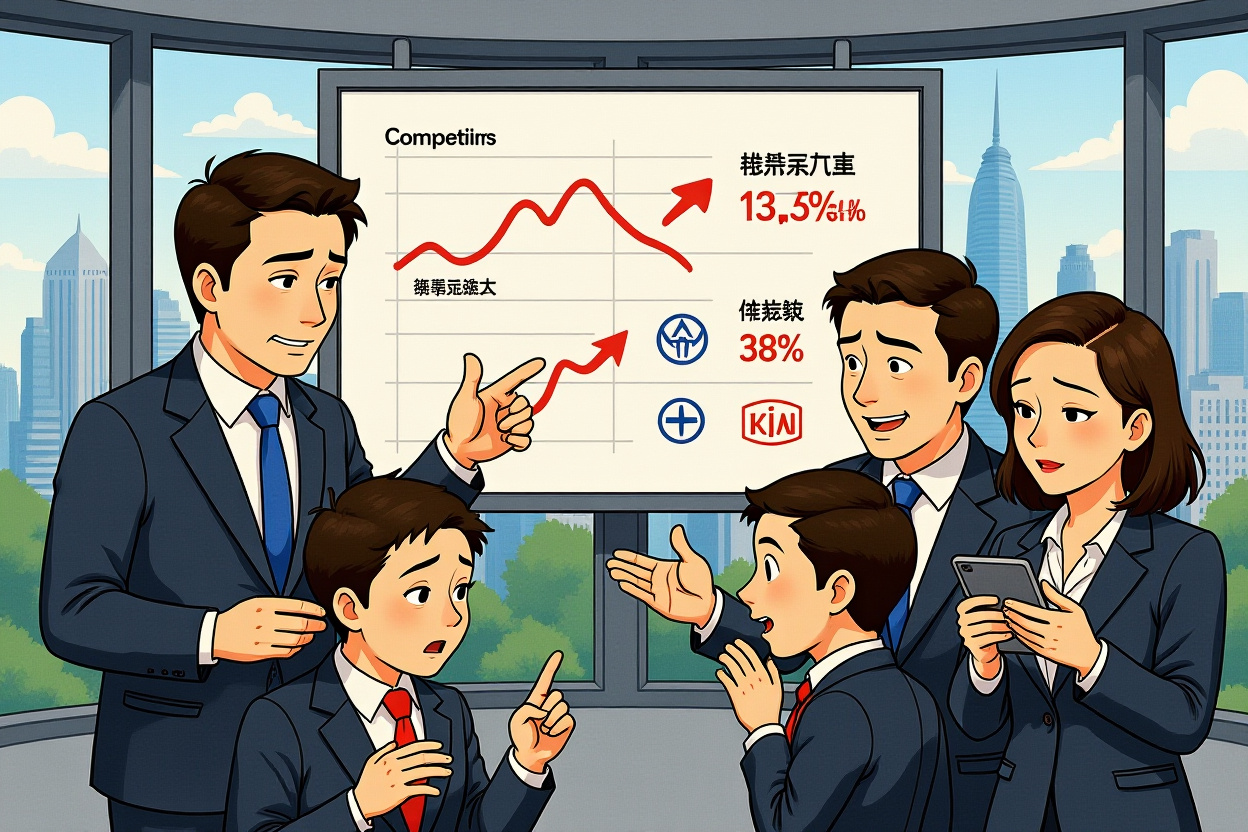Tesla’s grip on the U.S. electric vehicle market is showing clear signs of weakening. In August, the company’s market share dropped to 38%, marking the first time since October 2017 that it has fallen below the 40% threshold. While Tesla’s sales grew by 3.1% year-over-year, that growth was significantly outpaced by the overall EV market, which expanded by 14%. This slowdown highlights the mounting competitive pressure Tesla now faces from both legacy automakers and new entrants. The decline in Tesla’s market share isn’t an isolated event—it follows a sharp drop in July, when its share fell from 48.7% to 42%, the largest single-month decline since March 2021. For years, Tesla enjoyed near-total dominance in the electric vehicle space. But as the market matures and consumer choice expands, competitors are beginning to close the gap. This article explores the factors behind Tesla’s shrinking market share and what it means for the future of electric mobility.
Competition Heats Up: Legacy Automakers Fight Back
One of the biggest drivers behind Tesla’s declining market share is the aggressive push by traditional automakers into the EV space. Companies like Hyundai, Honda, Kia, and Volkswagen have ramped up production, improved technology, and—most importantly—deployed aggressive sales strategies to attract buyers. In August alone, these brands saw electric vehicle sales surge between 60% and 120% compared to the previous year, far exceeding Tesla’s growth rate.
Incentives and Discounts Drive Sales
A key factor helping legacy automakers gain traction is their willingness to offer significant purchase incentives. While Tesla has historically avoided discounts or rebates, brands like Volkswagen are leveraging promotions such as zero-down-payment options and complimentary fast-charging programs to sway potential buyers. One California-based car shopper noted that these kinds of offers were the deciding factor in choosing a VW ID.4 over a Tesla Model Y. – Hyundai and Kia: Offering long-range warranties and complimentary charging partnerships. – Volkswagen: Promotional campaigns including no-money-down leases and free EA fast charging. – Honda and GM: Introducing more affordable models with stronger feature sets compared to Tesla’s entry-level offerings. These tactics are clearly resonating with cost-conscious consumers who are increasingly comparing EVs not just on performance, but on value.
Tesla’s Strategy Shift: From Mass Market to High-Tech Futures
Another critical element influencing Tesla’s market performance is the company’s evolving strategic vision. Under CEO Elon Musk, Tesla has increasingly prioritized long-term technological projects—such as fully autonomous robotaxis and humanoid robots—over the development of new mass-market vehicles.
Delayed and Canceled Affordable Models
Perhaps the most consequential decision has been the delay, and possible cancellation, of plans for a more affordable Tesla model. Often referred to as the “Model 2,” this vehicle was intended to compete directly with lower-priced EVs from rivals. By shifting focus away from this high-volume segment, Tesla has left a gap in its product lineup that competitors are now exploiting. This has had a direct impact on Tesla’s market share, particularly among first-time EV buyers and budget-conscious consumers. Without a true entry-level offering, Tesla is increasingly dependent on its premium models, which face stiffer competition than ever before.
Brand Perception and Political Factors
Tesla’s brand has long been associated with innovation, sustainability, and cutting-edge technology. However, recent controversies surrounding CEO Elon Musk and his political affiliations may be influencing consumer perception. Musk’s very public alignment with right-wing politics and figures like former President Donald Trump has sparked backlash among some environmentally and socially conscious buyers—a demographic that has historically been a core part of Tesla’s customer base. While it is difficult to quantify the exact impact of these associations on sales, there is growing evidence that polarizing political stances can affect brand loyalty and purchasing decisions in the automotive market.
Market Dynamics and Consumer Behavior
The U.S. electric vehicle market is rapidly evolving. What was once a niche segment dominated by a single player is now a crowded, competitive field. Consumers today have more choices than ever, from luxury EVs like the BMW i4 to affordable options like the Chevrolet Bolt. – Increased Model Availability: Nearly every major automaker now offers at least one fully electric model. – Improved Charging Infrastructure: Third-party networks are expanding, reducing reliance on Tesla’s Supercharger ecosystem. – Growing Consumer Awareness: Buyers are more informed and more willing to consider alternatives to Tesla. These trends have collectively contributed to the erosion of Tesla’s market share. While the company remains the market leader by a significant margin, its dominance is no longer unchallenged.
What’s Next for Tesla and the EV Market?
Tesla’s decline in market share does not necessarily signal a decline in the company’s overall influence or innovation. However, it does underscore the fact that the EV market is entering a new phase—one defined by competition, segmentation, and strategic execution. For Tesla to maintain its leadership position, it may need to revisit its product roadmap and re-engage with the mass market. The company’s upcoming Cybertruck and Semi may attract media attention, but it is affordable, high-volume models that will ultimately determine its ability to retain market share. At the same time, legacy automakers must continue executing their EV strategies effectively, ensuring that supply chain stability, production quality, and customer experience keep pace with demand. The EV revolution is far from over—in many ways, it’s just beginning. For consumers, this increased competition means more options, better prices, and accelerated innovation. For industry watchers, it marks the start of a more dynamic and unpredictable chapter in the story of electric mobility. Stay informed with the latest developments in the auto industry by following our coverage and analysis.




